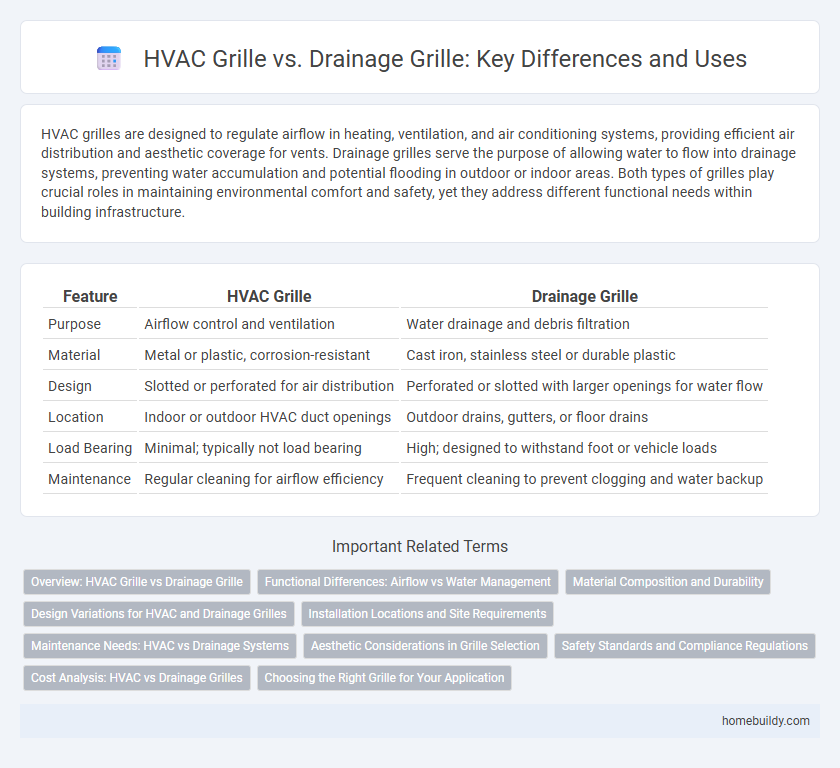HVAC grilles are designed to regulate airflow in heating, ventilation, and air conditioning systems, providing efficient air distribution and aesthetic coverage for vents. Drainage grilles serve the purpose of allowing water to flow into drainage systems, preventing water accumulation and potential flooding in outdoor or indoor areas. Both types of grilles play crucial roles in maintaining environmental comfort and safety, yet they address different functional needs within building infrastructure.
Table of Comparison
| Feature | HVAC Grille | Drainage Grille |
|---|---|---|
| Purpose | Airflow control and ventilation | Water drainage and debris filtration |
| Material | Metal or plastic, corrosion-resistant | Cast iron, stainless steel or durable plastic |
| Design | Slotted or perforated for air distribution | Perforated or slotted with larger openings for water flow |
| Location | Indoor or outdoor HVAC duct openings | Outdoor drains, gutters, or floor drains |
| Load Bearing | Minimal; typically not load bearing | High; designed to withstand foot or vehicle loads |
| Maintenance | Regular cleaning for airflow efficiency | Frequent cleaning to prevent clogging and water backup |
Overview: HVAC Grille vs Drainage Grille
HVAC grilles are designed to regulate and direct airflow within heating, ventilation, and air conditioning systems, typically featuring adjustable louvers to control ventilation efficiency. Drainage grilles serve as protective covers for drainage systems, allowing water to pass through while preventing debris from clogging pipes and maintaining proper water flow. Both types of grilles are essential for building maintenance but differ significantly in function, materials, and placement.
Functional Differences: Airflow vs Water Management
HVAC grilles are designed to regulate and direct airflow within heating, ventilation, and air conditioning systems, optimizing indoor air quality and temperature control. Drainage grilles, on the other hand, focus on water management by facilitating the efficient removal of surface water to prevent flooding and water accumulation. The key functional difference lies in HVAC grilles prioritizing air distribution, while drainage grilles ensure effective water drainage.
Material Composition and Durability
HVAC grilles are commonly made from aluminum or steel, offering corrosion resistance and durability essential for managing airflow and temperature control. Drainage grilles typically utilize materials like cast iron or stainless steel, designed to withstand constant exposure to water and heavy loads without rusting or degrading. The material composition directly influences each grille's longevity, with HVAC grilles focusing on thermal performance and drainage grilles prioritizing water resistance and mechanical strength.
Design Variations for HVAC and Drainage Grilles
HVAC grilles feature adjustable louvers and aerodynamic designs to regulate airflow efficiently, often incorporating materials that withstand temperature fluctuations and humidity. Drainage grilles are engineered with larger, closely spaced slats or perforations to prevent debris infiltration while ensuring rapid water flow and durability against corrosive elements. Both designs prioritize functionality specific to their applications, with HVAC grilles focusing on air distribution and drainage grilles emphasizing effective water management.
Installation Locations and Site Requirements
HVAC grilles are typically installed in walls, ceilings, or floors to facilitate air flow within heating, ventilation, and air conditioning systems, requiring clear access to ductwork and unobstructed air pathways. Drainage grilles are positioned over floor drains in areas exposed to water, such as bathrooms, kitchens, or outdoor surfaces, and must be installed level with the floor surface to ensure efficient water flow and prevent pooling. Site requirements for HVAC grilles prioritize ventilation efficiency and air circulation, while drainage grilles demand waterproofing considerations and load-bearing capacity to handle foot traffic or equipment weight.
Maintenance Needs: HVAC vs Drainage Systems
HVAC grilles require regular cleaning to prevent dust buildup that can impair airflow and reduce system efficiency, ensuring optimal indoor air quality. Drainage grilles demand frequent inspection and removal of debris to prevent clogs that can cause water pooling and structural damage. Proper maintenance of both grille types is critical for prolonging system lifespan and maintaining functional performance in heating, ventilation, air conditioning, and drainage systems.
Aesthetic Considerations in Grille Selection
HVAC grilles prioritize airflow efficiency and often feature streamlined designs to complement interior aesthetics while maintaining unobtrusive ventilation. Drainage grilles focus on durability and water flow management, with materials and patterns chosen to prevent debris accumulation and withstand moisture exposure. Selecting grilles requires balancing aesthetic appeal with functional demands, considering factors such as material finish, pattern style, and integration with surrounding architectural elements.
Safety Standards and Compliance Regulations
HVAC grilles and drainage grilles serve distinct purposes with specific safety standards and compliance regulations crucial for building safety. HVAC grilles are designed to meet air quality and fire safety codes such as NFPA 90A, ensuring proper airflow and preventing fire spread within ventilation systems. Drainage grilles must comply with standards like ADA for slip resistance and load capacity, preventing water accumulation hazards and ensuring pedestrian safety in drainage systems.
Cost Analysis: HVAC vs Drainage Grilles
HVAC grilles typically incur higher upfront costs due to material durability and design complexity required for air flow efficiency, ranging from $50 to $200 per unit. Drainage grilles tend to be more cost-effective, priced between $20 and $80, as they primarily focus on water drainage and corrosion resistance. Maintenance expenses for HVAC grilles often exceed those for drainage grilles because of filters and mechanical components that require regular servicing.
Choosing the Right Grille for Your Application
Selecting the appropriate grille between HVAC and drainage systems depends on airflow requirements and moisture management needs. HVAC grilles optimize air distribution and filtration in heating, ventilation, and air conditioning setups, while drainage grilles prevent water accumulation by allowing efficient surface water flow. Evaluating environmental conditions and system function is critical for ensuring durability, performance, and safety in your specific application.
HVAC Grille vs Drainage Grille Infographic

 homebuildy.com
homebuildy.com